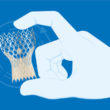Cardiogenic shock will develop in approximately 10% of patients with ST elevated acute MI (STEMI), and unfortunately, only half of these patients will survive. Researchers have been looking into the Impella system to manage this severe complication. It consists of an aortic transvalvular pump designed to deliver blood from the left ventricle into the systemic...
ACC 2024 | ULTIMATE-DAPT Trial
The international guidelines recommend the use of dual antiplatelet therapy (DAPT) with aspirin plus a P2Y12 inhibitor during 12 months in patients receiving percutaneous coronary intervention (PCI) for acute coronary syndrome (ACS), to prevent events such as MI and stent thrombosis. This was a multicenter, placebo controlled, double blind study to determine whether ticagrelor alone,...
TAVR in the Different Types of Aortic Stenosis
Aortic stenosis (AS) is classified according to gradient into high flow and high gradient (D1), low flow-low gradient with reduced ejection fraction (D2), and paradoxical low flow-low gradient with conserved ejection fraction (D3). D3 AS is characterized by ≥50% ejection fraction, but with systolic volume index ≤35 ml/min. Post TAVR evolution of D2 and D3...
Transcatheter Myotomy for the Treatment of the Dynamic Obstruction of the Left Ventricular Outflow Tract
Septal reduction therapies are used to mitigate the symptoms caused by dynamic left ventricular outflow tract (LVOT) obstruction and the associated mitral regurgitation (MR) that can surge in hypertrophic cardiomyopathy (HCM). Alternative therapies to treat LVOT obstruction include surgical procedures, i.e. surgical myotomy or myomectomy, or alcohol and radiofrequency septal ablation (intracardiac, transthoracic and endocardial,...
Rehospitalization After Treatment of Left Main Coronary Artery Disease and Its Prognosis: Sub-Analysis of the EXCEL Study
Individual randomized studies have shown variable results regarding the mortality risk following treatment of left main coronary artery disease (LMCAD), either through percutaneous coronary intervention (PCI) or coronary artery bypass grafting (CABG). However, upon assessment of the latest meta-analyses (with matched data), similar risks of all-cause and cardiovascular mortality have been reported for both groups....
TENDER Study, Evolution at One Year
The use of transcatheter mitral valve intervention for the treatment of mitral valve regurgitation (MR) continues to evolve; at present guidelines only recommend it for inoperable or high surgical risk patients. So far, many devices have been assessed, some of which have shown promising results, but only for poor surgical candidates. Researchers looked into the...
Post TAVR Long Term Outcomes in Patients with Chronic Inflammatory Disease
Patients suffering from immune-mediated chronic inflammatory disease (CID) face a high risk of developing heart disease, including aortic valve disease. Inflammatory vascular disease when triggered by an autoimmune condition, can prompt a harmful response leading to valve degeneration, with increased calcification and fibrosis, and the associated progression of stenosis, failure or both. Prior research has...
Should We Use Ultrasound Routinely to Guide Transfemoral Access?
Currently, transfemoral access (TFA) is used in large-caliber procedures and when transradial access fails. The introduction of ultrasound (US) to guide access has emerged as a technique that allows for precise channeling, avoiding accesses above or below the inguinal ligament. However, evidence regarding the use of this tool has shown diverse results. Two surveys conducted...
Short-Term Outcomes of TAVR in Asymptomatic or Minimally Symptomatic Patients
Aortic valve replacement (AVR) is indicated for symptomatic aortic stenosis (AS), while close follow-up is recommended for asymptomatic patients, unless they have elevated aortic gradients, low ejection fraction, or abnormal stress tests. However, the optimal timing to perform AVR is uncertain, especially with recent evidence suggesting that patients with AS associated with signs of myocardial...
PCI Evolution in Infiltrative Diseases
Infiltrative diseases (ID) consist of a heterogeneous series of genetic conditions that cause infiltration and extracellular deposits which alter the diverse systems and organs affected. Amyloidosis, sarcoidosis and hemochromatosis affect the heart, altering the myocardium and the conduction system. PCI is often used at present to treat heart disease, and some of these patients present...








